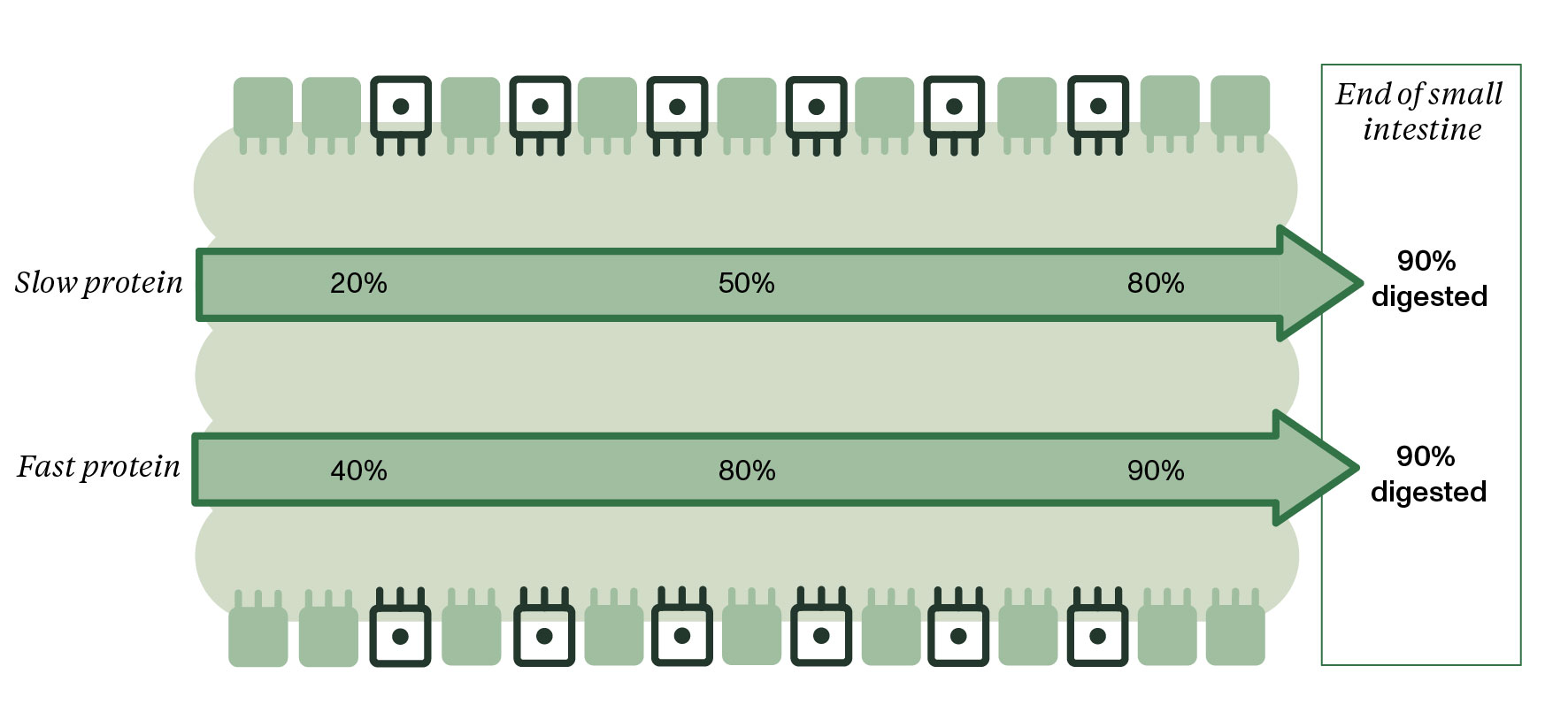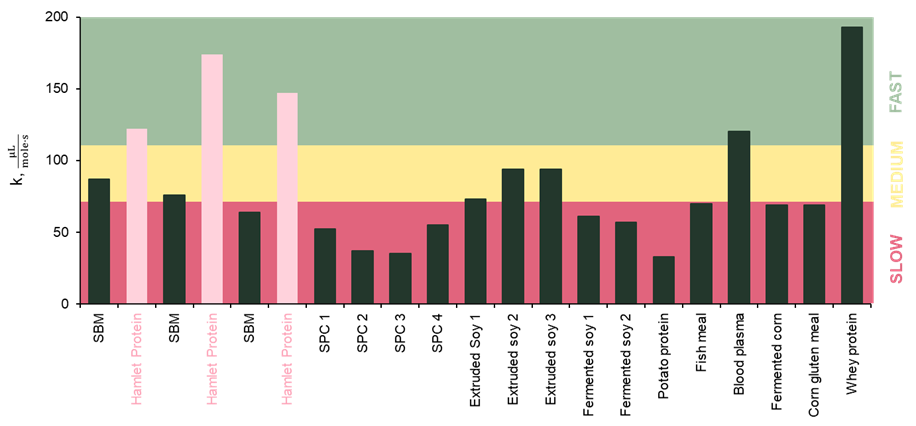Protein kinetics: Why should nutritionists care? Better use of protein results in a reduction of N-excretion
By Hamlet Protein
Protein kinetics is all about the speed of protein digestion. The faster a protein source is digested and absorbed the faster it becomes available for the animals. Research now shows that faster protein ingredients are also better used for growth and performance than slower ingredients which means less protein is wasted. Knowing the protein kinetics of a protein source will allow nutritionists to formulate diets with a higher protein biological value, optimising animal performance and therefore feed cost, and reducing nitrogen excretion into the environment.Hamlet Protein produces the fastest vegetal protein.
Hamlet Protein has been involved in a large research project to unravel the differences in digestion speed between protein sources. The results of this project are surprising. Some protein sources generally considered as highly digestible and fit for young animals turned out to be extremely slow in their digestion speed. The results of this research have been published recently at the ASAS-CSAS-WSASAS meeting in the USA.¹
The reason for this is that digestibility considers all protein that disappears throughout the length of the small intestine and accounts that as digested. Even though that theoretically this is true it matters where in the small intestine the protein (amino acids) was absorbed to ensure it was actually used for tissue formation.
The more proximal (closer to the stomach) a protein is absorbed the more of the protein sources is used for tissue building and less is lost through nitrogen excretion via the kidneys while the opposite is true for protein (amino acids) that is absorbed more distal (closer to the end of the ileum). Of slow protein relatively more nitrogen is excreted and less is used for tissue building.

Table 1: Effect of slow or fast protein on nitrogen deposition in growing pigs. Adapted from Zhang et al., 2022.
What is protein kinetics precisely about?
Two protein sources can have similar ileal digestibility coefficients but may differ largely in the speed and site of digestion, and absorption (Figure 1). Consider for instance blood meal and high protein soybean meal (SBM-HP) which both show similar digestibility coefficients at the end of the small intestine (after which is assumed no enzymatic protein digestion occurs anymore).
For blood meal, however, a lot more protein is hydrolysed already in the first part of the small intestine (proximal jejunum) while for SBM-HP more is hydrolysed in more distal parts of the small intestine. In this study, this means that the protein digestion is faster for blood meal than for SBM-HP. So, protein kinetics is a more accurate description of what actually happens with the protein inside the animal than digestibility alone.
Protein kinetics considers not only that a protein is digested but also where it is digested, and the resulting amino acids are absorbed.

Figure 1: percentage of digested protein in different parts of the digestive tract.
Why speed matters
Digestion speed is important because the most efficient hydrolysation and absorption occurs in the jejunum, a part of the small intestine which is closer to the stomach. The reason for this is that glucose is abundantly available as an energy source for the intestinal cells in the jejunum that absorb the amino acids. This means that they can perform optimally and therefore, a greater proportion of amino acids pass into the bloodstream. Consequently, a smaller proportion needs to be oxidised to generate energy. Conversely, less glucose is available further down in the ileum. Therefore, intestinal cells located here will have to use a larger proportion of the amino acids as an energy source, so that the functions of these intestinal cells can continue to be carried out.3,4,5
Furthermore, insulin growth factor (IGF), which regulates the deposition of amino acids (AA) in tissues, reaches peak levels soon after feed consumption, which favours the deposition of AA during peak levels of IGF. So, the faster a protein is hydrolysed and absorbed, the more of the protein will be used for protein deposition. Fast absorbable protein ingredients improve nitrogen (N) retention and consequently growth and feed efficiency of the animals.
Recent trial work in weaned pigs at Hamlet Protein showed that despite higher crude protein intake because of higher feed intake in pigs, fed a fast protein diet using vegetal plasma (HP300) as a protein source, total faecal nitrogen excretion did not differ from pigs on a slow protein (SPC) diet. This indicate that the faster protein digestion speed of the vegetal plasma (HP300) led to a higher feed intake and as a result a higher average daily CP intake. The similar faecal nitrogen excretion indicates a better overall protein utilization for the vegetal plasma (HP300) which was confirmed by significant higher ADG and BW for pigs on vegetal plasma (HP300).
So, from fast protein less nitrogen is wasted. Therefore, protein kinetics are more indicative of feed efficiency and protein deposition than the digestibility coefficient of the protein ingredient.
Formulating diets with protein kinetics
Young animals have a very high protein requirement but underdeveloped digestive capacity.
They need a lot of protein to further develop their organs, while not fully equipped to extract all the required amino acids from the protein in the diet.
In the current practice of feed formulation, digestible amino acids, and net or metabolizable energy contents are used as fixed values of feed ingredients to optimise diets. This is quite convenient but limited as it ignores the variation in nutrient kinetics of different ingredients and does not account for interactions happening between ingredients before and after absorption.
Hamlet Protein collaborated with Aarhus University to test the kinetics of a variety of protein sources as the best way to determine protein kinetics is by mimicking digestion in vitro. Results of these studies revealed that from all vegetal protein sources, Hamlet Protein products show the fastest protein hydrolysis in vitro and even outperforms animal protein like fish meal and blood plasma (see figure 2).

Figure 2: Speed of protein hydrolysation as measured by the hydrolysis constant k[µL/(mole*s); µL=microliter NaOH needed to keep pH at 8 during hydrolysis (acid is released) and s=seconds for soy-based protein, fish meal, blood plasma, fermented corn, corn gluten meal, and sweet whey when incubated with proteolytic enzymes for 120 minutes.
These results have consequences for diet formulation. First, young animals have a high requirement for fast protein and need a total inclusion of more than 12% of a fast protein source (incl synthetic AA) in their diets (piglets). Secondly, when looking to replace a protein source like for instance blood plasma, it is important to replace it with an equally fast protein source in order not to change the total protein kinetics of the diet.
Vegetal plasma
The unique production process of Hamlet Protein using enzymatic treatment does not only effectively reduce the content of anti-nutritional factors, but it also modifies protein characteristics in such a way that it becomes more accessible for proteolytic enzymes, resulting in a very fast protein source. Protein from Hamlet Protein hydrolyses faster than SBM and a lot faster than protein from SPCs. The Hamlet Protein portfolio outperforms all vegetal protein sources when it comes to kinetics, but also is faster than some of the tested animal proteins like fish meal and blood plasma. It is therefore considered a premium protein ingredient; fast, clean (low ANF’s) and safe (no biosecurity risk).
References
Bible et al., (2023).
Toghyani et al., 2020.
Van den Borne et al., 2007.
Liu and Selle, 2017.
He and Wu, 2022.
Discover the benefits of fast protein kinetics
The use of fast protein improves production efficiency and growth performance. Faster protein digestion leads to a faster absorption of amino acids after feeding, which increases the protein availability for tissues, milk and organs. The resulting rapid and synchronized absorption of amino acids increases protein deposition and thus reduces feed conversion rate.

